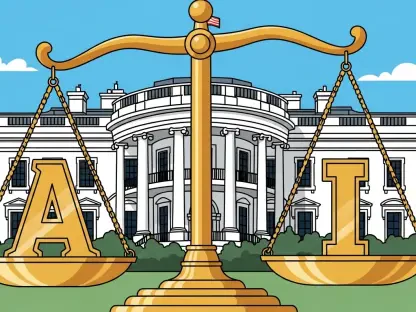Setting the Stage for a Transatlantic Tech Clash
Imagine a world where the rules governing the internet are dictated by a single region, imposing hefty fines and strict controls that reshape how global tech giants operate. This scenario is unfolding as the European Union’s Digital Services Act (DSA) sparks a heated conflict with the United States, threatening to redefine the digital landscape. With billions of dollars at stake and fundamental values like free speech under scrutiny, the tension between these two economic powerhouses has reached a critical juncture, drawing attention from industry leaders and policymakers alike.
This report dives into the escalating rift between the US and EU over digital regulations, focusing on the DSA’s impact on American tech companies and the broader implications for the industry. As the EU pushes for stringent oversight of online platforms, the US government, alongside major players like Meta, is gearing up for a potential showdown. The stakes are high, not only for business interests but also for the future of global tech standards and user protections.
The analysis ahead explores the core issues fueling this dispute, the strategies employed by key stakeholders, and the geopolitical undercurrents shaping the debate. By examining economic, ideological, and regulatory dimensions, this report aims to provide a comprehensive overview of a conflict that could alter the trajectory of the tech sector worldwide.
Understanding the US-EU Tech Regulation Conflict
The friction between the US and EU over digital regulations has intensified with the implementation of the DSA, a landmark piece of legislation designed to hold tech platforms accountable for content moderation, user data practices, and transparency. Enforced across the EU, this act targets large online platforms, many of which are US-based, imposing strict compliance requirements and significant penalties for violations. This has created a rift, as American firms find themselves at odds with European regulators over the scope and fairness of these rules.
At the heart of this conflict are key players such as Meta, which has borne the brunt of EU fines, and the Trump Administration, which has taken a vocal stance against what it perceives as regulatory overreach. EU regulators, on the other hand, argue that the DSA is essential for safeguarding user rights and ensuring a level playing field in the digital economy. The significance of this clash extends beyond regional borders, as it could set precedents for how tech governance is approached globally, influencing markets far beyond Europe and America.
This dispute is not merely a legal or financial issue; it represents a broader struggle over who controls the digital realm. With the tech industry serving as a cornerstone of modern economies, the outcome of this regulatory battle could redefine competitive dynamics, innovation incentives, and the balance of power between governments and corporations in the digital age.
Core Issues Driving the US Opposition
Economic Concerns and Business Impact
One of the primary drivers of US opposition to the DSA is the substantial financial burden it places on American tech companies. Meta, for instance, has faced annual fines averaging over $1 billion due to non-compliance with EU regulations, a figure that underscores the economic toll of these rules. Such penalties not only strain corporate budgets but also divert resources from innovation to legal and compliance efforts, creating a ripple effect across the industry.
The US government views these regulations as disproportionately targeting American businesses, arguing that they undermine the competitiveness of domestic firms in the global market. Officials contend that the EU’s approach seems designed to penalize the success of US tech giants while favoring European counterparts, raising concerns about fairness and economic protectionism. This perspective has fueled a push for diplomatic and policy interventions to shield American companies from what is seen as discriminatory oversight.
Beyond individual companies, the broader economic implications are significant. If unchecked, these regulatory costs could dampen investment in the US tech sector, slow growth, and cede market share to competitors operating under less stringent regimes. This fear of economic disadvantage is a key motivator behind the US stance, as policymakers seek to protect a vital industry from external constraints.
Ideological Differences and Free Speech Debates
Beyond economics, ideological differences play a crucial role in the US opposition to the DSA, particularly concerning free speech. The Trump Administration has argued that the EU’s regulations impose restrictions on expression by mandating content moderation practices that may censor lawful speech. US Secretary of State Marco Rubio has publicly framed the DSA as a threat to democratic values, asserting that it prioritizes control over individual liberty.
This clash reflects a fundamental divergence in how the US and EU approach tech governance. While the EU emphasizes user protection and societal harm prevention through strict oversight, the US traditionally favors platform autonomy, viewing minimal regulation as essential to fostering open dialogue. This philosophical divide complicates efforts to find common ground, as each side holds firm to its principles.
The debate over free speech extends to practical implications for users and platforms alike. American critics warn that EU-style content rules could set a dangerous precedent, potentially leading to broader censorship or suppression of diverse viewpoints. Resolving this ideological standoff will require careful negotiation, as it touches on deeply held beliefs about the role of technology in democratic societies.
Challenges and Strategies in the Regulatory Battle
Navigating the EU’s regulatory landscape presents formidable challenges for US tech firms, with compliance costs soaring as companies adapt to complex and evolving requirements. Beyond financial penalties, firms must overhaul operational practices, from data handling to content moderation, often at significant expense. These adjustments can disrupt business models, particularly for companies reliant on user data for revenue generation.
Meta, as a prominent example, has adopted strategic measures to mitigate these challenges, aligning itself with the Trump Administration’s policy priorities. This includes implementing platform features that resonate with US political narratives and appointing key figures like Joel Kaplan, a Republican, to lead global affairs. Such moves are calculated to gain favor with American policymakers, potentially securing stronger governmental support against EU regulatory pressures.
These strategies, however, are not without risks, as they may alienate other stakeholders or fail to fully address the root issues of compliance. The broader challenge lies in balancing the demands of multiple jurisdictions while maintaining profitability and user trust. For many US firms, the path forward involves a mix of legal advocacy, political lobbying, and operational innovation to weather the regulatory storm.
The Broader Geopolitical and Regulatory Landscape
The US-EU tech regulation conflict cannot be viewed in isolation; it is deeply intertwined with broader geopolitical tensions. Past trade disputes, including threats from the Trump Administration to impose tariffs on European imports, highlight a pattern of using economic leverage to influence policy. These actions suggest that the current dispute over the DSA could escalate into a larger transatlantic confrontation, with tech policy serving as a battleground for wider economic grievances.
Additionally, the EU’s regulatory ambitions extend beyond the DSA, encompassing emerging areas like AI innovation, where new rules aim to ensure ethical development and deployment. The US has criticized these additional frameworks as further evidence of European overreach, arguing that they stifle technological advancement and burden American innovators. This comprehensive approach by the EU amplifies the stakes of the current conflict, as it signals a long-term intent to reshape the global tech ecosystem.
Geopolitical dynamics add another layer of complexity, as both regions vie for influence over international tech standards. The outcome of this regulatory tug-of-war could determine which model of governance—US-style deregulation or EU-style oversight—gains prominence globally. As other nations observe this clash, their own policies may shift, potentially reshaping alliances and economic relationships in the digital sphere.
Future Implications for Tech and International Relations
Looking ahead, the US-EU conflict over digital rules poses significant risks, including the possibility of a broader showdown that could fracture transatlantic cooperation. If unresolved, this dispute may lead to fragmented global tech standards, with regions adopting divergent approaches that complicate cross-border operations for companies. Such fragmentation could hinder innovation and raise costs for businesses navigating a patchwork of regulations.
The impact on users remains a critical, yet unresolved, question. EU regulations like the DSA offer enhanced protections, such as greater control over personal data and transparency in content moderation. However, US concerns about reduced regulation suggest that overly strict rules might limit platform freedom, potentially stifling user engagement or access to diverse content. Balancing these competing priorities will be central to shaping future policies.
On a larger scale, the outcome of this conflict could redefine international relations in the tech domain, influencing how power is distributed between governments and corporations. A failure to reach a compromise might embolden other regions to assert their own regulatory frameworks, further complicating the global landscape. The tech industry must prepare for a period of uncertainty, as the resolution of this dispute will likely set the tone for digital governance in the years ahead.
Reflecting on the Transatlantic Tech Divide
Looking back, the clash between the US and EU over the Digital Services Act unfolded as a pivotal moment, revealing deep-seated economic and ideological divides. The substantial fines imposed on companies like Meta, coupled with the Trump Administration’s staunch opposition, underscored the high stakes involved. This regulatory battle illuminated the challenges of aligning diverse governance models in a globally interconnected digital economy.
Moving forward, stakeholders need to prioritize dialogue and collaboration to bridge the gap between user protections and business interests. A potential solution lies in establishing joint frameworks that address core concerns like free speech and economic fairness without resorting to punitive measures. Both sides stand to benefit from compromise, ensuring that innovation thrives while safeguarding user rights.
As the tech industry evolves, the lessons from this conflict urge a reevaluation of how international regulations are crafted and enforced. Industry leaders and policymakers must consider hybrid models that draw from both US and EU perspectives, fostering a more cohesive global standard. This approach promises to mitigate future disputes, paving the way for a more balanced and sustainable digital future.









